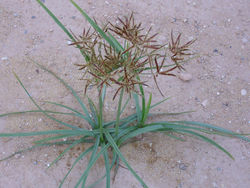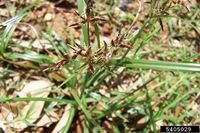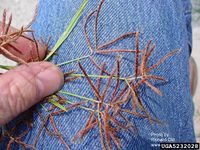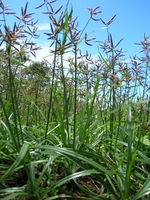Difference between revisions of "Cyperus rotundus (weed)"
| Line 3: | Line 3: | ||
[[File:Cyperus rotundus Habitus 2010-7-11 LagunadelaMata.jpg|250px|thumb|''Cyperus rotundus'' (click on image to enlarge it)<br/>Author(s): Javier Martin<br/>Source: [http://commons.wikimedia.org/wiki/File:Cyperus_rotundus_Habitus_2010-7-11_LagunadelaMata.jpg Wikimedia Commons]]] | [[File:Cyperus rotundus Habitus 2010-7-11 LagunadelaMata.jpg|250px|thumb|''Cyperus rotundus'' (click on image to enlarge it)<br/>Author(s): Javier Martin<br/>Source: [http://commons.wikimedia.org/wiki/File:Cyperus_rotundus_Habitus_2010-7-11_LagunadelaMata.jpg Wikimedia Commons]]] | ||
<font color="#800000">'''''Cyperus rotundus'' (weed)</font>''' (L.) Palla - (purple nutsedge)<br/> | <font color="#800000">'''''Cyperus rotundus'' (weed)</font>''' (L.) Palla - (purple nutsedge)<br/> | ||
| − | is a common and serious perennial weed in subtropical and tropical regions around the world. Its biology and weed status is similar to [[Cyperus esculentus (weed)|yellow nutsedge]]. However, it can be easily distinguished by its purple to red-brown flower heads. It has dark-green foliage and its tubers are arranged in chains along the rhizomes. The tubers are about 1-2 cm long and are not edible. Commonly, affected crops include cereals (e.g. maize and rice), vegetable (e.g. tomato or pepper), soybean, sugarcane and cotton. Yield losses of more than 50% have been reported. The plants grow to a height of more than 1 m. | + | is a common and serious perennial weed in subtropical and tropical regions around the world. Its biology and weed status is similar to [[Cyperus esculentus (weed)|yellow nutsedge]]. However, it can be easily distinguished by its purple to red-brown flower heads. It has dark-green foliage and its tubers are arranged in chains along the rhizomes. The tubers are about 1-2 cm long and are not edible. Commonly, affected crops include cereals (e.g. maize and rice), vegetable (e.g. tomato or pepper), soybean, sugarcane and cotton. Yield losses of more than 50% have been reported for some crops. In India, studies on soybean showed a yield reduction of about 10% at a density of 20 ''C. rotundus'' plants per m<sup>2</sup>. The plants grow to a height of more than 1 m. |
Control depends mainly on destroying the persistent tubers which typically grow at a depth of 15-20 cm. The seeds are mostly not viable. Summer tillage is recommended for control, as tuber can be killed by leaving them drying on the soil surface for several days. Other control methods include crop rotation, herbicides, mulches and thick plastic covers. | Control depends mainly on destroying the persistent tubers which typically grow at a depth of 15-20 cm. The seeds are mostly not viable. Summer tillage is recommended for control, as tuber can be killed by leaving them drying on the soil surface for several days. Other control methods include crop rotation, herbicides, mulches and thick plastic covers. | ||
Revision as of 09:46, 30 April 2014
Taxonomic position
|
|---|
no parent categories |
| Literature database |
|---|
| 311 articles sorted by: |
| • year (recent ones first) |
| • research topics |
| • countries/regions |
| • affected crops |
| • list of natural enemies |
Cyperus rotundus (weed) (L.) Palla - (purple nutsedge)
is a common and serious perennial weed in subtropical and tropical regions around the world. Its biology and weed status is similar to yellow nutsedge. However, it can be easily distinguished by its purple to red-brown flower heads. It has dark-green foliage and its tubers are arranged in chains along the rhizomes. The tubers are about 1-2 cm long and are not edible. Commonly, affected crops include cereals (e.g. maize and rice), vegetable (e.g. tomato or pepper), soybean, sugarcane and cotton. Yield losses of more than 50% have been reported for some crops. In India, studies on soybean showed a yield reduction of about 10% at a density of 20 C. rotundus plants per m2. The plants grow to a height of more than 1 m.
Control depends mainly on destroying the persistent tubers which typically grow at a depth of 15-20 cm. The seeds are mostly not viable. Summer tillage is recommended for control, as tuber can be killed by leaving them drying on the soil surface for several days. Other control methods include crop rotation, herbicides, mulches and thick plastic covers.
| Vernacular names | |
|---|---|
| • Deutsch: | rundes Zypergras |
| • English: | purple nutsedge nutgrass |
| • Español: | cebolleta |
| • Français: | souchet rond |
| • Português: | tiririca |
For details see the respective page in Wikipedia.
- Other images of Cyperus rotundus (weed) (Wikimedia Commons and IPM Images - click to enlarge)




